Deploying files using Mapped Folders
With Visual Studio 2010 SharePoint Developer Tools, the concept of the Mapped Folder was introduced. A mapped folder is a convenient way for developers to specify a location for any files that need to be deployed on to the SharePoint file system, all from within in a Visual Studio solution. Mapped folders can be included as part of a deployment package (.WSP) and the files will get copied to the correct location when the WSP is installed on to the server.
Let’s take a quick look at how a developer might use a mapped folder. Say a developer wants to develop a custom application page for their SharePoint site that will consume a custom image. The SharePoint server has a designated location for both application pages and images. With mapped folders, the developer can ensure that their files will be deployed to the correct location. Here’s an example:
First we need to create a project. In this example, we will start by creating an Empty SharePoint project (Installed Templates->Visual Basic/C#->SharePoint->2010).
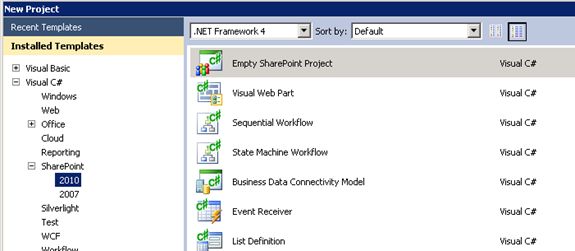
Next, we’ll create our custom image that we want to display. First, let’s setup a mapped folder to the Images directory on the SharePoint farm. To do this, we simply right-click on the project node and select “Add->SharePoint “Images” Mapped Folder”:
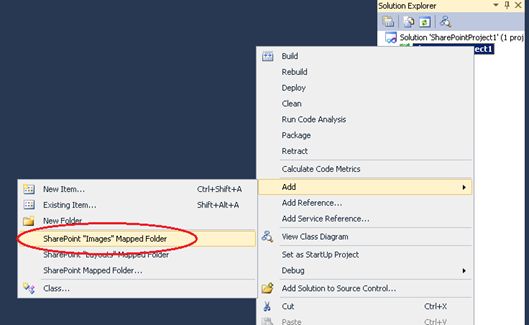
This will create a mapped folder named “Images” in our project. (You can also create it via the “Project->Add SharePoint “Images” Mapped Folder on the main menu bar”)
In the Solution Explorer, mapped folders look very similar to normal folders but have a small green globe in the bottom right corner of the icon. You’ll notice that underneath the mapped folder there is a sub folder with the same name as the project. This is to help organize images specific to your project and keep developers from inadvertently overwriting another item with the same name.
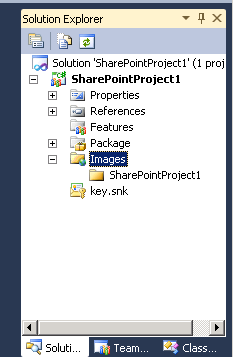
Also, if you select the mapped folder and open the property window (F4), you’ll see two entries: Folder Name and Deployment Location. The Deployment Location indicates the location relative to the SharePoint root directory ({SharePointRoot}) on the SharePoint farm.
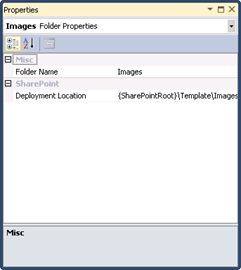
Now that we have our mapped folder, we can right-click on the project directory underneath it and add our image file (“Add->New Item’). In this example, I’ve added a bitmap image named ”Bob.bmp”.
The next step is to create the application page and modify it to show our image. To start, right-click on the project node in the Solution Explorer and select “Add->New Item”. When the Add New Item dialog appears, the “2010” node under SharePoint will be selected. From the list of templates, select the “Application Page” item, give it the name you want, and click “Add”. You’ll notice that when the application page is added to the project, it automatically gets created under the “Layouts” mapped folder, which is the default location on the SharePoint file system for application pages:
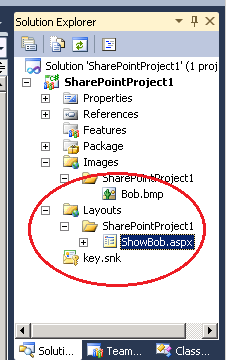
Following its creation, the .aspx file we just added should be opened in the designer. Locate the <asp:Content> element with the ID equal to “Main”. Within that element add an image element and set the ImageUrl attribute to point to the image in your product. It should look like this:
<asp:Content ID="Main" ContentPlaceHolderID="PlaceHolderMain" runat="server"><asp:Label ID="Label1" runat="server" Text="Label" Font-Size="Medium">This is Bob.......</asp:Label><asp:Image ID="Image1" runat="server" ImageUrl="~/_layouts/Images/SharePointProject1/Bob.bmp" /></asp:Content>
The last thing we’ll want to do to make testing our project easier is to set the application page to be our startup item when we F5. To do this, select the project node in the Solution Explorer and open the property window (F4). In the property window, select the “Startup Item” property and choose our application page from the drop down list. Now when we F5, it will take us right to our application page:
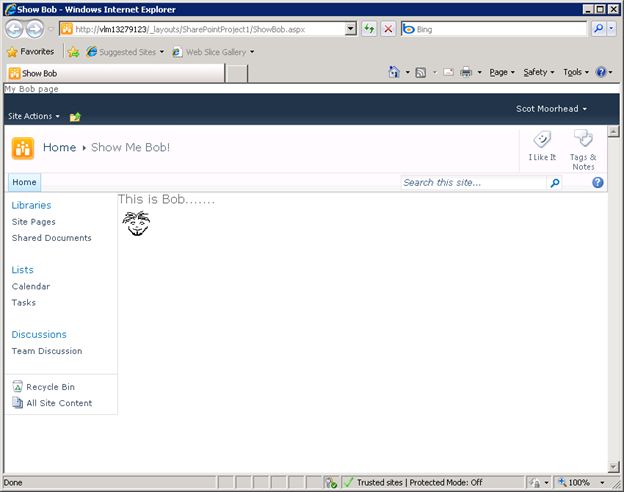
A couple of things to know about mapped folders. First, since mapped folders effectively deploy files onto the SharePoint file system, they are only allowed in farm level solutions. Sandboxed solutions are restricted to only deploying content to the content database on the server. In VS, when you try add a mapped folder to a sandboxed solution, the package validation will generate an error regarding this.
Second, as you saw when we added the application page, some items go into certain mapped folders by default when they are added to the project. Another example is User Control items (.ascx) which are automatically placed into the User Control mapped folder. While these are the SharePoint “default” locations, there may be times you need to place one of these files in a different location, and this can be done by mapping the folder to a different location.
Finally, you can create a mapped folder to any folder under the SharePoint root on the farm by opening the Add SharePoint Mapped Folder dialog (Project->Add SharePoint Mapped Folder… from main menu, Add->SharePoint Mapped Folder… from project context menu:
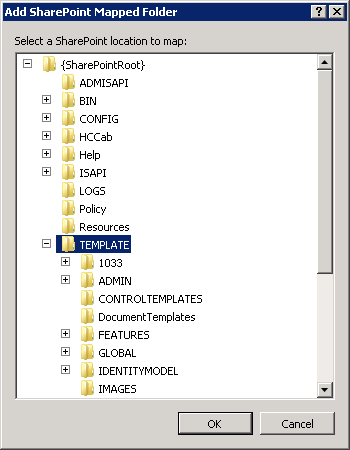
For instance, if you had a custom web service you wanted to deploy to the SharePoint server, you could simply add a mapped folder that points to the ISAPI directory on the SharePoint file system and dropped the web service in there. Then, when the package gets deployed to the server, the web service will automatically be placed in the ISAPI directory and available for consumption.